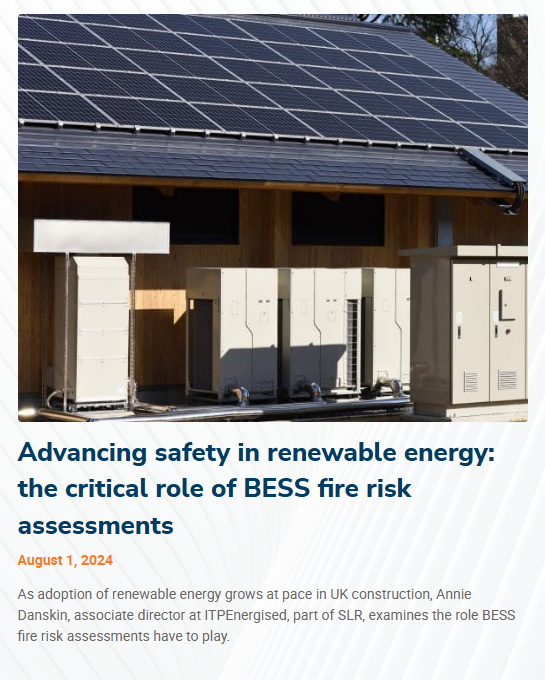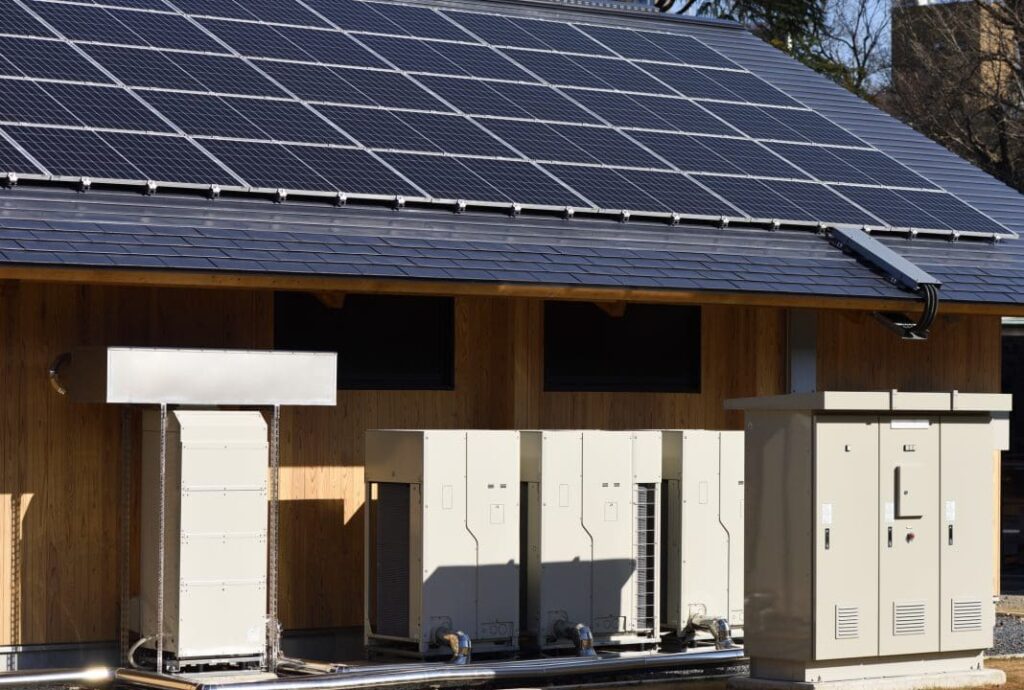As adoption of renewable energy grows at pace in UK construction, Annie Danskin, Associate Director at ITPEnergised, part of SLR, examines the role BESS fire risk assessments have to play
As the renewable energy sector continues to grow rapidly, the implementation of Battery Energy Storage Systems (BESS) has become increasingly important. These systems play a crucial role in addressing the sector’s ongoing challenge of storing and distributing clean energy.
However, they also present unique safety challenges that the industry must address proactively. There is an obvious need to develop an innovative approach to BESS fire risk assessment that goes beyond current regulatory requirements, aiming to inform emergency response plans, enhance safety, build community trust and support the sustainable growth of renewable energy projects.
Public perception and safety concerns
The current planning processes for renewable energy sites such as solar, wind, BESS or hydrogen facilities often focus heavily on risk prevention strategies. While prevention is undoubtedly critical, there is a notable gap in addressing what the potential impacts would be for local communities and the environment if a fire does occur. Fires at BESS sites are now rare due to advancements in guidance, technology and numerous fundamental design and engineering improvements made in recent years.
However, public perception of safety often lags behind these advancements. Local communities have expressed concerns about BESS installations and lodged objections to planning applications, citing past incidents of fires involving older battery technologies. Objections can lead to project delays or even cancellations, hindering the broader adoption of renewable energy solutions.
There is therefore a real need to ensure the planning application system provides planning officers, developers, emergency responders and local communities access to a robust risk assessment to contextualise the risks if a fire does occur.
Challenges for fire and rescue teams
An additional concern that has been raised by some fire and rescue teams consulted on planning applications for BESS developments is the number of available entry points to a site in the event of a fire. Thick, smoky plumes can significantly impede visibility, making it challenging for teams to access the site quickly and safely.
Due to this, there is a need for clear and concise advice regarding the potential buffer zones where visibility could be impeded around areas where a fire could take place, as this may result in the requirement for additional access points. The plume visibility assessment can inform the Emergency Response Plan of the probability that local road closures would be temporarily required for safety reasons due to poor visibility.
The assessment can also indicate areas that may need to be evacuated to protect the public from smoke and other emissions. Potential impact areas are highly dependable on the varying weather and terrain conditions of each site, and each assessment needs to be bespoke depending on its location and surrounding topography.
As well as this, the prediction of the likely mix and concentrations of contaminants in the plume can assist the fire and rescue services to ensure their personnel are provided with the appropriate personal protective equipment, to protect them against exposure to hazardous gases that may be present.
The development of a comprehensive risk assessment methodology that includes dispersion modelling of BESS fires goes beyond standard safety protocols to provide a more thorough understanding of potential risks and their impacts.
Financial implications for developers
This nuanced and comprehensive understanding of potential risks enables developers to understand wider constraints that could influence the layout of the site and cause financial, and programme impacts. Knowing how a potential fire is likely to disperse in prevailing meteorological conditions could influence the number of access points required, leading to potential development changes. For example, if a certain area of developable land is planned to accommodate 200 containers with a capacity of 400 megawatts, the need for additional access points might reduce the usable land area, impacting the overall feasibility of the development plan.
The key here is for developers to consider these potential constraints early in the planning process, saving money and time and avoiding additional costs and delays in construction at a later date. By conducting a thorough and robust risk assessment, developers can limit design iterations and demonstrate that due consideration has been given to fire risk to aid in the development of a site-specific emergency response plan.
Improved understanding of BESS fire risk assessments will build trust
Overall, developers and local authorities can make more informed decisions about BESS siting, design and operational procedures, based on a clearer understanding of potential risks. Transparent communication of thorough risk assessments can help address community concerns and build trust in renewable energy projects.
Detailed risk assessments provide valuable support for developers during public consultations and planning applications, potentially streamlining the approval process. Additionally, local fire departments and other emergency responders gain access to site-specific information that can improve their response strategies and protect public safety.
Looking towards the future, the renewable energy sector will continue to evolve and grow, and with this, the approach to safety and risk management must also advance. Although enhanced BESS fire risk assessment is not currently a regulatory requirement, it is considered to represent best practice that the industry should embrace and meets the recommendations of the National Fire Chiefs Council. With a robust approach grounded in test data and the use of industry-standard atmospheric dispersion modelling that incorporates local topography and weather conditions, an assessment is typically deliverable within 6-8 weeks.
By taking a proactive stance on safety, we can protect communities and first responders while building the public trust necessary for the continued growth of renewable energy. The renewable energy revolution is well underway and with the right approach to risk assessment and management, we can ensure it proceeds safely and with the full support of communities.

As we work towards a cleaner, more sustainable future, we must ensure that safety remains at the forefront of our innovations. By doing so, we can accelerate the adoption of renewable energy technologies while maintaining the highest standards of public safety and the environmental protection we need.
This article appeared in PBC Today on August 1, 2024. For more information, please contact Annie Danskin at annie.danskin@itpenergised.com.

